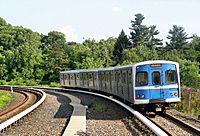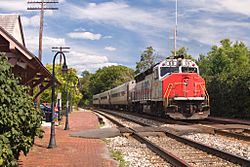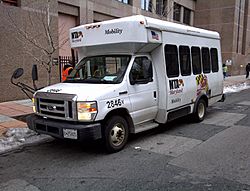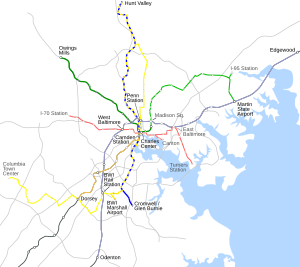Maryland Transit Administration facts for kids
Quick facts for kids Maryland Transit AdministrationMTA Maryland |
|
|---|---|
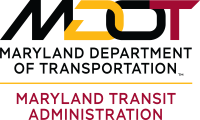 |
|
| Info | |
| Locale | Baltimore-Washington Metropolitan Area |
| Transit type | Bus Light rail Heavy rail Commuter rail |
| Number of lines | Heavy rail: 1 Light rail: 3 Commuter rail: 3 Bus: 80 |
| Number of stations | Heavy rail: 14 Light rail: 33 Commuter rail: 43 |
| Daily ridership | 380,100 (Q2 2016) |
| Chief executive | Holly Arnold |
| Operation | |
| Began operation | April 30, 1970 |
| Operator(s) | Maryland Department of Transportation |
| Number of vehicles | Heavy Rail: 100 Light Rail: 53 Commuter rail: 175 Bus: 842 Mobility vans: 303 Mobility sedans: 124 (2010) |
| Technical | |
| System length | Heavy rail: 15.2 miles (24.5 km) Light rail: 30 miles (48 km) Commuter rail: 187 miles (301 km) |
| Track gauge | 4 ft 8 1⁄2 in (1,435 mm) standard gauge |
The Maryland Transit Administration (MTA) is a state-operated mass transit administration in Maryland, and is part of the Maryland Department of Transportation. The MTA operates a comprehensive transit system throughout the Baltimore-Washington Metropolitan Area. There are 80 bus lines serving Baltimore's public transportation needs, along with other services that include the Light Rail, Metro Subway, and MARC Train. With nearly half the population of Baltimore residents lacking access to a car, the MTA is an important part of the regional transit picture. The system has many connections to other transit agencies of Central Maryland, Washington, D.C., Northern Virginia, and south-central Pennsylvania (Hanover, Harrisburg, and York): WMATA, Charm City Circulator, Regional Transportation Agency of Central Maryland, Annapolis Transit, Rabbit Transit, Ride-On, and TransIT.
Contents
History
The MTA took over the operations of the old Baltimore Transit Company on April 30, 1970. It was originally known as the Baltimore Metropolitan Transit Authority, then the Mass Transit Administration before it changed to its current name in October 2001.
Many of the routes of most of the agency's current bus lines are based on the original streetcars operated by the Baltimore Transit Company and its parent companies from the 1890s to the 1960s. All these routes were ultimately converted to rubber tire bus operations, and many of them were consolidated, extended into newly developed areas, or otherwise reconfigured to keep up with the ridership demands of the times. Additional routes and extensions were added in later years to serve communities that were later developed, and to feed into Metro and Light Rail stations that were later built.
With the growth in popularity of the private automobile during the 20th century, streetcar and bus ridership declined, and the needs for public transportation changed. Mass transit in Baltimore and other cities shifted from a corporate operation to a tax-subsidized state-run service. The amount of service provided was greatly reduced, and some areas once served by streetcars are currently served by buses very minimally or not at all. The demise of the Baltimore streetcar took place between the years of 1947 and 1963, as operators found buses to be low maintenance and more cost-efficient. As rails were demolished, Baltimore was no longer a streetcar city. As transit needs and trends changed, rail transit did return to the city, with the Metro Subway opening in 1983 and the Light Rail in 1992. The track gauge was 5 ft 4 1⁄2 in (1,638 mm), a unique gauge.
Rail services
Heavy rail (Metro Subway)
This system operates elevated and underground from a corporate and shopping complex in Owings Mills in Baltimore County into the heart of Downtown Baltimore City's business, shopping and sightseeing districts to the world-renowned Johns Hopkins Medical Center Complex. The 15.5-mile (24.94 km) northwest-southeastbound route includes 14 station stops. Its route through the densest parts of the city is underground, from Hopkins Hospital to a portal west of Mondawmin station, where it immediately rises to an elevated concrete right of way parallel to Wabash Avenue practically at the city line.
Entering Baltimore County, the line goes to surface, passing through communities along the way to commuter based stops at Milford Mill Road (Pikesville) and Old Court Road (Pikesville). From Old Court, the tracks pass underneath the I-695/795 interchange, and travel the median of 795 till their end at Owings Mills (Painter's Mill Road) This station is the centerpiece of a huge project intending to urbanize that immediate area, with a Baltimore County Public Library branch, and classroom space for the Community College of Baltimore County under construction. Residential and commercial development is planned to follow the completion of the education buildings.
There are efforts underway to extend the line northeast through the city with phase 1 to Morgan State University and phase 2 beyond the city limits to the White Marsh Town Center area. If they come to fruition, the line will be renamed the Green Line, coordinating with the new Red Line (east-west Woodlawn/Security-Hopkins Bayview Hospital) in its preliminary engineering stage. Funding for the Green Line extension is still years from being secured but includes an option to extend it as light rail or BRT from Johns Hopkins Hospital.
Light rail
This service travels from a corporate, hotel, and shopping complex in Baltimore County’s Hunt Valley, through the suburbs north of Baltimore and northern Baltimore City and into the heart of downtown Baltimore's shopping, sightseeing, dining, and entertainment districts, past the harbor and through southern Baltimore City and finally to BWI Marshall Airport and Cromwell Station/Glen Burnie in Anne Arundel County. There is also a spur to Amtrak’s Baltimore Penn Station.
The Light Rail operates at grade for the most part, though it travels on bridges crossing several bodies of water. There are 33 station stops along the 30.0-mile (48.28 km) system. Although much of the line was single-tracked when it was built, the MTA completed a double-tracking project on February 26, 2006, and now only a few short single-track sections remain.
Commuter rail (MARC)
This service operates three lines that provide commuter rail service to riders out of and into Baltimore, Washington, D.C., Frederick, Perryville, and Martinsburg, WV, as well as several other locations in between.
Mobility services
Paratransit
The MTA began offering paratransit service for persons with disabilities in 1978 when it took over a mobility service in Baltimore previously operated by Lutheran Family Services. This mobility service is a "non-fixed route" service and consists of a fleet of specially converted Ford E-Series vans and Ford Crown Victorias. Some service is contracted out to MV Transportation and Veolia Transportation, but all vehicles are owned by MTA.
Taxi Access
A sub-service of the Paratransit program is MTA's Taxi Access program. The Taxi Access program ensures that any sufficiently physically disabled person that consistently requires Paratransit service can also qualify for the Taxi Access program. The Taxi Access program allows the bearer of a Taxi Access card to take a taxicab door-to-door within the limits of anywhere MTA Paratransit vans go; i.e. within 1/3 of a mile of an MTA public transit stop of any kind. Once the trip is complete, total out-of-pocket cost for the customer is $3.00, and the MTA picks up the rest of the price of the fare, "paying" it to the driver in the form of a voucher that s/he later redeems at his/her cab company headquarters.
Proposed services
Currently the MTA is studying a number of proposed services, which includes the Red Line (a proposed east–west light rail line that would pass from Woodlawn pass near Patterson Park) to Johns Hopkins Bayview Med. Ctr. and the Green Line (a proposed north–south line that would extend from the Johns Hopkins Hospital into northeast Baltimore, possibly as an extension of the Metro Subway). As of summer 2011, the Red Line has received federal permission to enter preliminary engineering. Efforts to fund both lines continue, with overall priority going to the Red Line as of now.
Outside of Baltimore the MTA is also studying the Purple Line between Bethesda and New Carrollton, and the Corridor Cities Transitway between Gaithersburg and Clarksburg. Both studies are evaluating bus rapid transit and light rail options.
Baltimore Link
BaltimoreLink Governor Larry Hogan announced $135 million in targeted investments to transform and improve transit throughout the Baltimore metropolitan area. The multi-phase plan will create an interconnected transit system, known as BaltimoreLink, and includes redesigning the entire local and express bus systems throughout Baltimore and adding 12 new high-frequency, color-coded bus routes that improve connections to jobs and other transit modes.
The BaltimoreLink system will deliver a unified transit network and includes renaming existing Maryland Transit Administration (MTA) modes: LocalLink (Local Bus), Light RailLink, Metro SubwayLink and MobilityLink to create an interconnected transit system. Other key elements of the BaltimoreLink system include transitways, transit hubs and transit signal priority.
A major component of the BaltimoreLink system is CityLink – 12 new, high-frequency, color-coded bus routes that will improve reliability and better connect riders to Amtrak, Commuter Bus, Light RailLink, MARC Train, Metro SubwayLink and other services in Baltimore and the surrounding suburbs. In Baltimore City, new CityLink routes will run every 10 minutes during peak periods and every 15 minutes during the midday. The new CityLink buses will be specially branded and travel on color-coded routes with easy-to-read signage and detailed maps that will make the system easier to use. The CityLink bus routes, Light RailLink and Metro SubwayLink will form an interconnected, one-transfer system. On the new system, a rider will be able to get from any stop to any other stop with only one transfer.
Our plan will provide more people access to 745,000 jobs through an interconnected transit system: •Over 130,000 more jobs will be accessible via high-frequency transit compared to the existing network – a 36.7% increase •205,000 more people will have access to high-frequency transit compared to the existing network – a 34% increase •30,000 more people will have access to transit by increasing the service area by approximately 18 square miles
With this comprehensive plan was developed to fix Baltimore’s broken transit system and revolutionize the way people get to where they need to go. It is a modern vision for transit in the city that will deliver a unified system, which residents, businesses and elected officials have demanded for years. Transportation Secretary Pete Rahn and Maryland Transit Administrator Paul Comfort met with elected officials, city leaders, Baltimore residents and other key stakeholders over several months to identify their top priorities to improve transit in Baltimore. During these outreach meetings, we heard many of the same concerns:
- Improve the bus system.
- It has the most daily riders and it does not work.
- Buses are overcrowded, run too infrequently on key routes and don’t show up on time.
- The transit system is very confusing and not user-friendly.
- The transit system is unreliable and should better link people to jobs, appointments, entertainment and other transit modes.
- The transit system should better serve transit-dependent riders in Baltimore while attracting riders who currently choose to drive because they cannot rely on transit.
We also analyzed and compiled the data and feedback from the Bus Network Improvement Project, including current and projected population and job trends, ridership patterns and transit route performance information to develop BaltimoreLink. But, we’re not done listening. We will immediately begin extensive public outreach efforts to educate citizens on the elements of the plan and seek their input on these changes. Public workshops, online forums, and hearings will start this November and continue until the June 2016 launch of the new ExpressBusLink service and the June 2017 launch of CityLink, along with the totally redesigned LocalLink bus system.
Controversy Even though there was community input from the Bus Network Improvement Project from Former MTA Administrator Robert Smith and Former Governor O'Malley. Some Residents feel it is a replacement of the cancellation of the Baltimore Red Line Project that was cancelled in June by Governor Larry Hogan.
Baltimore Link Proposed Routes
BaltimoreLink comprises three forms of bus service: CityLink, ExpressLink, and LocalLink. System maps can be view here: http://mta.maryland.gov/baltimorelink-bus-routes Draft 1
CityLink
- CityLink Blue: CMS & Security Square Mall/I-70 Park & Ride to Bayview
- CityLink Brown: White Marsh / Overlea to West Baltimore MARC
- CityLink Gold: CCBC Catonsville to Broadway North
- CityLink Green: Towson to West Baltimore MARC
- CityLink Lime: Randallstown to Fells Point
- CityLink Navy: Turners Station to Penn North
- CityLink Orange: Fox Ridge / Bayview to West Baltimore MARC
- CityLink Pink: CCBC Essex/Cedonia to West Baltimore MARC
- CityLink Purple: Rt. 40 & Rolling Road / Paradise Loop to Penn Station
- CityLink Red: Lutherville / Towson to Inner Harbor
- CityLink Yellow: Halethrope MARC / Kaiser Medical Center to Broadway North
- CityLink Silver: Curtis Bay to Penn Station
Express BusLink
- Express BusLink 100: Owings Mills to BWI Marshall Airport / Rail
- Express BusLink 101: Towson to Owings Mills
- Express BusLink 102: Lutherville / Towson to White Marsh
- Express BusLink 104: Cromwell Bridge Park & Ride to Johns Hopkins Hospital
- Express Bus Link 105: White Marsh to BWI Marshal Airport / BWI Business Park
- Express BusLink 106: Columbia to Charles Center
- Express Bus Link 107: Fort Meade to Patapsco
- Express Bus Link 210: Kent Island / Annapolis to Baltimore
- Express Bus Link 215: Baltimore to Annapolis
LocalLink
- No. 21 Mondawmin to Fells Point
- No. 22 Canton Crossing to Hampden
- No. 23 Canton Crossing to Walbrook Junction
- No. 24 Bayview to Mondawmin
- No. 25 Penn North to Bayview
- No. 26 Port Covington to Mondawmin
- No. 27 Turner Station to Better Waverly
- No. 28 Moravia Park to West Cold Spring
- No. 29 West Cold Spring to Brooklyn Homes
- No. 30 Bayview to Belvedere Square
- No. 31 Belvedere Square to Westview Mall
- No. 32 Wildwood Parkway to Patapsco
- No. 33 Rosedale (Chesaco Avenue) to Mt. Washington
- No. 34 Security Square Mall to Mt. Washington
- No. 35 Reisterstown Plaza to CCBC Catonsville
- No. 36 CCBC Essex to Towson
- No. 37 Rt. 40 & Rolling Road to Mt. Washington
- No. 38 Fox Ridge to White Marsh
- No. 39 CCBC Catonsville to Curtis Bay
- No. 40 Towson to White Marsh
- No. 51 Stella Maris to Johns Hopkins University
- No. 53 Cromwell Bridge Park & Ride to Morgan State University
- No. 55 Perry Hall / Carney Park & Ride to State Center
- No. 57 Belair-Edison Shuttle
- No. 59 Whispering Woods to Bayview
- No. 61 Eastpoint Mall to North Point Road
- No. 63 Lynch Road & Dundalk to Bayview
- No. 65 Dundalk Ave & Lynch Rd to Canton Crossing
- No. 67 Riviera Beach to Curtis Bay
- No. 69 Jumpers Hole to Patapsco
- No. 70 Annapolis to Cromwell / Glen Burnie
- No. 71 Patapsco to Charles Center
- No. 73 Patapsco to Charles Center
- No. 75 Parkway Center / Arundel Mills to Patapsco
- No. 77 Rt. 40 & Rolling Road to West Baltimore MARC
- No. 79 Dickeysville to Rt. 40 & Rolling Road
- No. 81 Deer Park Plaza to Old Court
- No. 83 Milford Mill to North Avenue
- No. 85 Milford Mill to Penn North
- No. 87 Glyndon to Owings Mills
- No. 89 Red Run Blvd / Owings Mills to Rogers
- No. 91 Mondawmin to Reisterstown Plaza
- No. 92 Glen & Key to Owings Mills Center
- No. 93 Hunt Valley to Lutherville
Fares
These are the current fare prices for MTA buses, Light Rail, and Metro Subway travel. There is a separate fare structure for MARC Train services.
| Service | Regular fare | Reduced fare |
|---|---|---|
| Neighborhood Shuttle | $1.70 | $0.70 |
| Local bus, QuickBus, Light Rail, Metro Subway | $1.70 | $1.10 |
| Express bus | $2.10 | $1.10 |
| Commuter bus | varies by destination | varies by destination |
| Inter-County Connector bus | varies by destination | varies by destination |
| MARC Train | varies by destination | varies by destination |
| Service | Regular fare | Reduced fare |
|---|---|---|
| Local bus, QuickBus, Neighborhood Shuttle, Light Rail, Metro Subway | $3.40 | $1.40 |
| Commuter bus | varies by destination | varies by destination |
| Inter-County Connector bus | varies by destination | varies by destination |
| MARC Train | varies by destination | varies by destination |
| Service | Regular fare | Reduced fare |
|---|---|---|
| Local bus, QuickBus, Neighborhood Shuttle, Light Rail, Metro Subway | $4.00 | $2.00 |
| Express bus | $4.40 | $2.10 |
| Commuter bus | varies by destination | varies by destination |
| Inter-County Connector bus | varies by destination | varies by destination |
| MARC Train | varies by destination | varies by destination |
| Service | Regular fare | Reduced fare |
|---|---|---|
| Local bus, QuickBus, Neighborhood Shuttle, Light Rail, Metro Subway | $22.00 | - |
| Express bus | $22.00 | - |
| Commuter bus | varies by destination | varies by destination |
| Inter-County Connector bus | varies by destination | varies by destination |
| MARC Train | varies by destination | varies by destination |
| Service | Regular fare | Reduced fare |
|---|---|---|
| Local bus, QuickBus, Neighborhood Shuttle, Light Rail, Metro Subway | $68.00 | $20.00 |
| Express bus | $85.00 | $20.00 |
| Commuter bus | varies by destination | varies by destination |
| Inter-County Connector bus | varies by destination | varies by destination |
| MARC Train | varies by destination | varies by destination |
- Note: Express bus fare is $0.40 plus from base fare on Local bus, Neighborhood Shuttle, Light Rail, and Metro Subway services.
| Type | Cost (USD) |
|---|---|
| One-Way | $1.90 |
- Note: People who qualify for paratransit services can use all MTA rail and bus services free of charge.
Fare collection methods
Prior to the summer of 2005, the MTA used an older fare collection system. Day passes purchased on buses were printed out by a separate machine from the bus fareboxes. It was possible to alter these passes so that they could used on other days and to sell them to other passengers or make duplicate passes and sell them to others for cheaper than the MTA's official fares. This was despite the fact that they were officially non-transferable.
The MTA has since installed new fareboxes on all of its buses that issue daily passes with magnetic strips; new ticket vending machines at Light Rail and Metro Subway stations issue identical passes including the weekly and monthly passes. Weekly and monthly passes are not sold on buses.
The newer day passes can be used only on the appropriate day because the machine encodes the date and expiration time in the magnetic strip, which is read when swiped through the magnetic reader. Swiping the pass also sets a time waiting period on reuse so the pass cannot be immediately handed to a different passenger and used for free boarding. This also makes it difficult for passengers to use counterfeit passes when boarding the bus, Light Rail, and Metro Subway.
The MTA continues to struggle with passengers who purchase day passes, use them, then resell them at a direct loss to the agency. State employees who possess a Maryland State Employee ID card can ride MTA local bus, Light Rail, and the Metro Subway free of charge. Any state employee with the ID card can get a continuation ticket to get through the gates on the Metro Subway. For the bus, the person shows the state employee ID card to the driver when boarding. On the Light Rail, they have to show the ID card only in the event of a fare inspection while other passengers show their tickets. MTA employees can also ride free of charge if they carry their MTA employee ID card.
The MARC Train service is preparing for the eventual integration with the regional SmarTrip smartcard-based fare system. The system will involve conductors using hand-held units to validate SmarTrip cards as well as the MTA's Maryland Transit Pass.
Maryland transit pass
The MTA plans to begin selling smart cards under the name CharmCard. These will be similar to, and compatible with, the Washington Metropolitan Transit Authority's regional smart card system, the SmarTrip card.
When the CharmCard system is fully implemented, it will be used not only on Maryland Transit Administration transit services, but will also be able to be used in Washington D.C. on all WMATA buses, the Washington Metro and on most local bus services in Northern Virginia. Likewise, the WMATA SmarTrip card will be accepted by the fareboxes used by the MTA.
Special programs
Baltimore City Public School System
An agreement between the Baltimore City Public School System and the Maryland Transit Administration provided eligible BCPSS students (usually students who live outside a predetermined area surrounding the school) during a school year with a color-coded booklet of dated tickets each month and an identification card. The tickets allowed students to ride on MTA buses, light rail, and subway free going to and from school. The farebox was able to issue magnetic transfers to ticket holders who must use more than one bus. They were valid for 90 minutes of unlimited travel at the driver's discretion. In 2011, a new agreement was put in place for the students. Instead of the color-coded booklet, they were issued a monthly bus pass called an S-Pass. It's a bus pass that is valid for the given month from 6AM until 8PM. The S-Pass can allow students to ride and pass though an unlimited times through the Metro Subway gate, unlike the transfers from the color-coded booklet from in the past.
MTA college pass
The Maryland Transit Administration has a special program set up with 24 Baltimore area colleges and universities which allows college students who are enrolled in a minimum of 6 hours per week can receive a monthly pass for $50.00.
Participating colleges
- Anne Arundel Community College
- Baltimore City Community College
- Baltimore International College
- Catonsville Community College
- Notre Dame of Maryland University
- Coppin State University
- Dundalk Community College
- Essex Community College
- Harrison Career Institute
- Johns Hopkins University
- Homewood Campus
- School of Medicine
- School of Nursing
- School of Public Health
- School of Radiology
- Morgan State University
- Stevenson University (formerly Villa Julie College)
- Towson University
- University of Baltimore
- University of Maryland, Baltimore
- University of Maryland, Baltimore County
Maryland public transit laws
Section 7-705 of the Maryland Transportation article (Annotated Code of Maryland) enumerates a list of acts specifically prohibited on public transit vehicles, with penalties of fines and possible jail terms for violations. In addition to the enumerated rules of behavior, Section 7-705 also allows the MTA to enforce local government laws on public transit vehicles. Many of these rules are conspicuously posted on transit vehicles, bus stops and rail platforms. However, they are rarely enforced, making many unpleasant trips for those who actually follow these rules.
Images for kids
See also
 In Spanish: Administración de Transporte de Maryland para niños
In Spanish: Administración de Transporte de Maryland para niños


